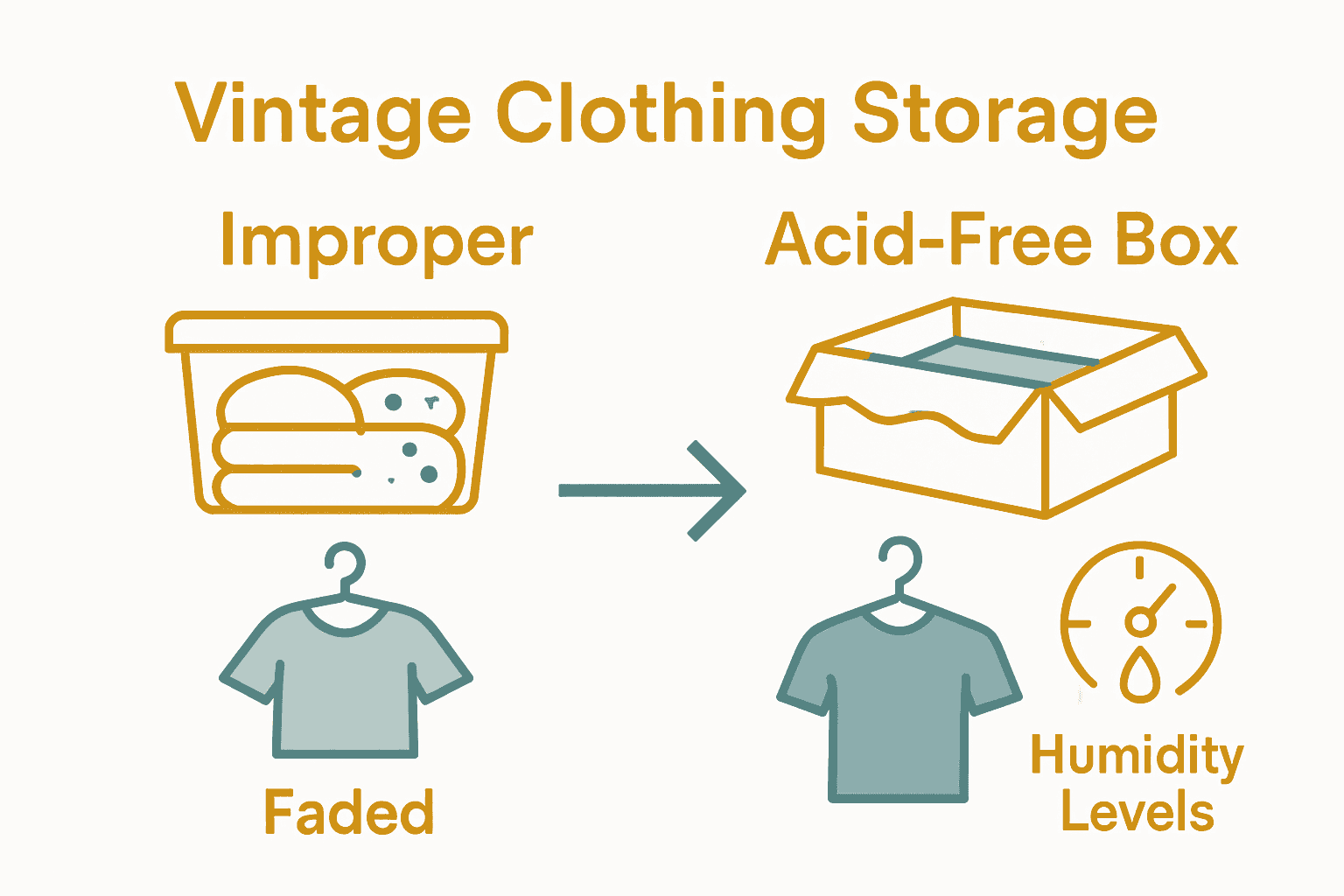How to Store Vintage Clothing for Lasting Preservation
- Emma

- 2 days ago
- 8 min read

Vintage clothing collectors know that neglect can destroy a cherished piece faster than any passing trend. The market for preserved garments has surged, with some rare finds increasing in value by over 300 percent in just a decade. Caring for vintage clothing matters because it safeguards both history and investment. This step-by-step guide lays out practical, expert-backed methods to help you protect your unique wardrobe and celebrate its lasting beauty.
Table of Contents
How to Store Vintage Clothing: Quick Summary
Step 1: Assess and clean vintage garments
Preparing your vintage clothing for long-term preservation requires a careful and systematic approach. This step focuses on thoroughly examining and gently cleaning your treasured garments to ensure their longevity and maintain their unique historical charm.
Start by carefully inspecting each vintage piece in good natural light. Look for signs of wear such as loose threads, delicate fabric, small tears, or potential insect damage. As recommended by Icon, if you discover any evidence of insect activity near your textile collection, it is crucial to consult a professional conservator who can provide expert guidance on prevention and monitoring.
Cleaning vintage garments demands a gentle touch. Always check the fabric type and consult care labels if available. For delicate items, consider hand washing with a mild detergent specifically designed for vintage fabrics. Avoid harsh chemicals or vigorous scrubbing that could damage fragile materials. According to Less Waste, learning basic repair skills like careful stitching can help maintain your clothing and extend its wearable life.
If you are unsure about cleaning a particularly delicate or valuable piece, it is best to seek professional textile restoration services. These experts can safely clean and restore vintage garments without risking further damage. Remember that proper cleaning is the first step in preserving your vintage clothing collection for years to come.
Step 2: Select suitable storage materials
Choosing the right storage materials is fundamental to preserving the integrity and beauty of your vintage clothing collection. In this step, you will learn how to select protective materials that prevent damage and maintain the delicate condition of your treasured garments.
The key to effective vintage clothing storage lies in using acid-free and archival quality materials. As recommended by the National Trust, large flat acid-free boxes work best for storing clothing with minimal folding. Consider using soft tissue paper ‘sausages’ and ‘puffs’ to support delicate areas and prevent unwanted creasing. For smaller textile items, Museums Galleries Scotland suggests using Melinex archival polyester sleeves which offer excellent protection from dust and potential handling damage.
When selecting storage containers, prioritise materials that are chemically inert and breathable. Cotton or muslin cloths can provide an additional protective layer for your vintage pieces. Avoid plastic containers or bags that can trap moisture and potentially cause mildew or fabric deterioration.

For larger textiles like dresses or coats, consider rolling them around a chemically neutral tube interleaved with acid-free tissue paper to prevent unnecessary stress on the fabric.
Remember that proper storage is an investment in your vintage clothing’s future. By taking time to select appropriate materials and storage techniques, you are helping to ensure that these beautiful historical garments remain in pristine condition for years to come.
Step 3: Prepare clothing for long-term storage
Preparing vintage clothing for long-term storage requires meticulous attention to detail and careful handling. Your goal is to create a protective environment that preserves the fabric, shape, and historical integrity of each precious garment.
According to Icon, the approach to storing garments varies depending on their condition and structure. For sturdy items in good condition, consider using padded hangers crafted from polyester wadding and covered with unbleached pure cotton. However, fragile or heavily decorated pieces should be stored flat in clean acid-free boxes with ample acid-free tissue paper to prevent unnecessary stress on delicate materials. The National Trust recommends minimizing fabric folds by using creative techniques like tissue paper ‘sausages’ and ‘puffs’ to support and cushion garments during storage.
Before placing any vintage clothing into long-term storage, ensure each piece is completely clean and thoroughly dry. Check for any loose threads, missing buttons, or potential repair needs. If possible, stuff delicate areas like sleeves and bodices with acid-free tissue to help maintain the garment’s original shape. Take extra care with structured pieces like vintage jackets or dresses that require more strategic padding and support.
Remember that proper preparation is your first line of defence in preserving vintage clothing. By taking time to carefully assess and position each piece, you are protecting not just a garment, but a piece of fashion history.
Step 4: Arrange and position items for best preservation
Arranging and positioning your vintage clothing collection requires thoughtful strategy to ensure maximum protection and minimal deterioration. This crucial step will help you create an optimal storage environment that safeguards your treasured garments.
Icon strongly recommends storing vintage items in a clean, dry, and dark location that allows for regular inspection. Pay close attention to protecting your textiles from dust, which can be surprisingly destructive. Dust particles are often acidic and can attract moisture and insects that could potentially damage your vintage pieces. As suggested by the National Trust, consider using large flat acid-free boxes that minimise fabric folding and incorporate clever padding techniques like tissue paper ‘sausages’ to prevent creasing and maintain the garment’s original shape.
When positioning different types of vintage clothing, create strategic layers within your storage containers. Heavier items should be placed at the bottom, with lighter and more delicate pieces carefully arranged on top. Use acid-free tissue paper between each garment to prevent colour transfer and provide additional cushioning. For particularly fragile or structured pieces like vintage dresses or jackets, consider using custom tissue paper supports to maintain their original silhouette. Avoid overcrowding your storage containers, as this can lead to unnecessary pressure and potential fabric distortion.

Remember that proper arrangement is an art form in vintage clothing preservation. By taking time to carefully position each piece, you are not just storing clothing you are protecting historical fashion artifacts that tell unique stories from different eras.
Step 5: Check and maintain storage conditions regularly
Regular monitoring and maintenance are essential to preserving the longevity of your vintage clothing collection. This step focuses on creating a systematic approach to protecting your treasured garments from potential environmental threats and gradual deterioration.
Museums Galleries Scotland emphasises the critical importance of vigilant housekeeping in textile storage. Just like professional museum collections, your vintage wardrobe requires consistent and careful attention. Plan to inspect your storage area and garments every three to six months, looking for early signs of potential damage such as discolouration, pest activity, moisture accumulation, or fabric stress. Pay particular attention to the storage environment temperature, humidity levels, and potential light exposure.
When conducting your routine checks, handle vintage items with clean hands or cotton gloves to prevent transferring oils or dirt. Gently refold garments along different lines to prevent permanent creasing and redistribute fabric stress. As recommended by the National Trust, use acid-free tissue paper to support and cushion delicate areas during repositioning. Look for any signs of insect activity, mould, or mildew and address these issues immediately to prevent widespread damage. Keep detailed records of each inspection, noting the condition of individual pieces and any interventions made.
Remember that consistent care is your most powerful tool in vintage clothing preservation. By dedicating time to regular maintenance, you are not just storing clothes you are actively protecting pieces of fashion history for future generations to appreciate and enjoy.
Preserve Your Vintage Treasures with Expert Care and Thoughtful Style
Storing vintage clothing requires more than just putting garments away. As highlighted in the article, the key challenges involve protecting delicate fabrics, using acid-free materials, and maintaining the original shape through careful padding and positioning. If preserving the charm and history of your vintage wardrobe feels overwhelming, you are not alone. Many collectors wrestle with avoiding fabric damage from dust, moisture, and improper folding while striving to honour each piece’s unique story.
At My Vintage, we understand the emotional value behind every garment and offer a curated selection of authentic vintage apparel and accessories that are not only timeless but also ready to be cherished for years. Whether you are looking to expand your collection or replace items lost to wear, our quality vintage clothing from the 1940s to the 1990s is carefully selected to meet the highest standards of preservation and style.

Discover how you can both protect your current collection and find new additions that embody sustainable fashion with historical significance on our website. Visit My Vintage now to explore a world of exquisite pieces and gain inspiration for maintaining your vintage wardrobe with love and care. Take the next step towards preserving fashion heritage while elevating your style today.
Frequently Asked Questions
How do I assess the condition of my vintage clothing before storage?
To assess the condition of your vintage clothing, inspect each piece in good natural light for signs of wear, such as loose threads, small tears, or insect damage. Take careful notes on any repairs needed and consider seeking professional help for valuable items before storage.
What materials should I use for storing vintage garments?
Use acid-free and archival quality materials, such as large flat acid-free boxes and acid-free tissue paper. Avoid plastic containers that can trap moisture; instead, opt for breathable materials like cotton or muslin to protect your garments.
How can I prepare my vintage clothing for long-term storage?
To prepare your vintage clothing, ensure each piece is clean, dry, and properly padded with acid-free tissue to maintain its shape. Store fragile items flat in acid-free boxes, while sturdier garments can be hung on padded hangers.
How should I arrange my vintage clothing for optimal preservation?
Arrange vintage clothing by placing heavier items at the bottom and lighter pieces on top to prevent distortion. Use acid-free tissue paper between garments to prevent color transfer and ensure ample space to avoid overcrowding.
How often should I check on my stored vintage clothing?
Inspect your stored vintage clothing every three to six months to identify any signs of damage, moisture, or pest activity. During each check, gently refold items along different lines to avoid permanent creasing and apply any necessary repairs promptly.
What signs of damage should I look for during inspections?
Look for discolouration, moisture accumulation, pest activity, or fabric stress during your inspections. Address any identified issues immediately to prevent further damage to your vintage garments.
Recommended







Comments